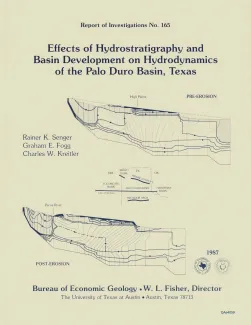
Publication Details
Geolocation:
Get the Publication
$11.00
Abstract/Description:
Deep brine aquifers of the Palo Duro Basin, Texas Panhandle, ranging in depth from about 1,000 to 3,000 m below land surface, are underpressured compared with the shallow Ogallala aquifer. Two-dimensional simulations of flow in an east-west regional cross-sectional model through the basin permitted us to characterize regional ground-water flow, to investigate causes of underpressuring below the Evaporite aquitard, and to evaluate mechanisms of recharge and discharge to and from the Deep-Basin Brine aquifer. Employing steady-state flow simulations, we investigated various effects of lithostratigraphy and topography on groundwater flow. We also used transient flow simulations to illustrate changes in regional hydrodynamics caused by different tectonic and geomorphologic processes.The regional ground-water flow regime in the Palo Duro Basin consists of a shallow ground-water flow system governed primarily by topography and a deeper flow system recharging in the New Mexico area and passing deep beneath the Pecos River into the deep section of the Palo Duro Basin. The low-permeability Evaporite aquitard limits flow between the shallow and deep systems, although leakage through the aquitard is important on a regional scale and could contribute a significant part of the water in the deep system. The ground-water flow pattern within the Deep-Basin Brine aquifer is strongly controlled by the spatial distribution of more permeable strata such as granite-wash deposits, which drain the deep aquifer system more easily than it is recharged.Repeated simulations with the model demonstrate that chief causes of underpressuring are regional topography and geology. Specifically, the Ogallala water table is relatively high owing to the elevation of the High Plains, the potentiometric surface of the Deep-Basin Brine aquifer is relatively low owing to the draining effect of permeable granite wash and very low recharge rates, and the low-permeability Evaporite aquitard effectively segregates the two aquifer systems, thereby maintaining the large head differential. The Pecos River valley serves as a discharge area for some ground water from the west that would otherwise move downdip into the deep aquifer; thus, capture of recharge water enhances underpressuring in the deep system beneath the western half of the High Plains.Simulations of the hydrodynamic development of the Palo Duro Basin as a result of successive tectonic and geomorphologic events indicate that Cenozoic uplift and tilting of the basin (10 to 15 mya) caused considerable increase in ground water flow rates. The timing of the erosional events implies that significant underpressuring (hydraulic-head difference between shallow and deep aquifers in excess of 175 m) occurred within the last 1 to 2 m.y. as a result of the erosional retreat of the Eastern Caprock Escarpment. The drastic change in hydraulic heads during that period suggests a significant effect on the overall ground-water flow pattern in the deep section within the last 1 to 2 m.y. Modeling also indicates that erosional unloading associated with the retreat of the Eastern Caprock Escarpment was ineffective in creating large-scale underpressuring in the Deep-Basin Brine aquifer. Only in the vicinity of the escarpment is it possible that erosional unloading and the resulting expansion of the underlying aquitard could create subhydrostatic conditions within the aquitard. Similarly, hydrocarbon production along the margins of the basin and the concomitant reduction in reservoir pressure affect hydraulic heads only locally and do not influence regional ground-water flow in the Deep-Basin Brine aquifer.